Lubrication: sliding between surfaces
Contents
Lubrication: sliding between surfaces¶
Our last application will be to surfaces sliding past each other with a thin film of liquid between them. As you know, the presence of a fluid can reduce the friction considerably.
If the surfaces are parallel the pressure is uniform and there is a frictional force exerted by the fluid, which you have worked out in various problem sets (eg the torque on a rotating disk), computed form the tangential stress.
However, if the surfaces are not quie parallel, pressure starts to become important, and in fact will dominate the force on the surfaces. This can be seen from dimensional analysis. Starting with the thin film equations
From this the pressure scales as \(\eta U L/h^2\). The tangential stress
scales as \(\eta U/h\) (see the first term, when \({\hat n}\) has a vertical component, this will be the dominant term). The ratio of this term to the pressure term is of order the aspect ration \(h/L\); the pressure force that is moving the bodies along dominates over the frictional force. The goal is to work out these pressure forces.
To this end we will proceed by working out a couple of examples. We will work with effectively 2d problems for simplicity.
Linearly sliding surfaces¶
In the first problem we consider a flat plate at \(z = 0\) moving at velocity \(U\) over a surface defined by \(z = h(x)\). The lateral variation of \(h\) will be important to us. The boundary conditions will be \(u = U\), \(w = 0\) at \(z = 0\) and \(u = w = 0\) at \(z = h\). The fluid will be taken to extend from \(x = 0\) to \(x = L\) with constant pressure \(p_0\) on each side.
As before, \(w \ll u, v\) means that \(]p_z p \ll \p_{x,y} p\) so we assume the pressure is independent of \(z\). Then we can solve for the first of the thin-film equations to find:
Demanding \(u = U\) at \(z = 0\) gives \(B = U\). Demanding \(u = 0\) at \(z = h\) gives
Thus
We next apply the incompressibility condition. Integrating this over a slice of constant \(x\), the integral over \(\p_z w\) vanishes as it is a total derivative with vanishing boundary tems (due to the boundary conditions on \(w\). The remaining term is
If we pull \(\p_x\) out of this integral, we get
because the boundary term vanishes. The upshot is that
the flux of fluid through any vertical section, is the same for all \(x\). We can compute \(Q\) from our solution:
Given this, we have a differential equation for \(p\):
We integrate this with the boundary condition that \(p = p_0\) at \(x = 0\), so that
From this, \(Q\) will be determined by the demand that \(p = p_0\) at \(x = L\):
First, it is easy to check that if \(h\) is constant, \(Q = U h/2\), \(p = p_0\) everywhere, and the fluid friction will dominate the force between the plates.
To get a more nontrivial answer we consider a linear slope for the top surface,
The integrals are doable if a bit annoying, but the upshot is that
and
If \(h_2 < h_1\) the top and bottom are negative so that \(p - p_0 > 0\), and we have a nontrivial pressure. Because of the slope there is a lateral component as well as a vertical component, and these will be large compared to the tangential stresses (by dimensional analysis, but it can be checked).
Eccentic rotating cylinders¶
The next example is a fixed outer cyliner with radius \(r = (1 + \eps) a\), and an off-center inner cylinder with radius \(a\) rotating with tangential velocity \(U = a\Omega\). We take the origin to be the center of the outer cylinder. The inner cylinder will be offset by \(a\eps\lambda\) with \(\lambda \in [0,1]\). The equation for the radial position of the inner cylinder is
The straightforward way to see this is to set \((x - a\eps\lambda)^2 + y^2 = a^2\), and rewrite in polar coordinates \(x = r \cos\theta\), \(y = r\sin\theta\). At fixed \(\theta\), the radial distance between the inner and outer cylinders is thus
If \(\eps \ll 1\), the local geometry of the surfaces are flat, and we can at any \(\theta\) approximate this by the previous example with a linear slope, with the coordinate \(x \sim a\theta\). The upshot is that
where \(z\) is the distance across the gap.
Similarly, we can use the incompressibility condition to demand that the flux btween the cylinders
is constant in \(\theta\). This is somewhat less trivial to integrate but it can be done. The boundary condition we must impose is that \(p(0) = p(2\pi)\). As ever, this boundary condition fixes \(Q\), which in this case is:
Note that if \(\lambda = 1\) the cylinders touch and the flow goes to zero, as you may expect. If \(\lambda = 0\), there is flow.
Next, we can try to get some information about \(p\). NOte that \(h(\theta)\) is even in \(\theta\). Looking at the equation for \(Q\), this means \(\p_{\thea} p\) is even, or \(p\) is odd. By symmetry, there is thus no force in the \(x\) direction, but there is a net force in the \(+y\) direction. If we integrate \(p(\theta)\), we find that
so the load on the inner cylinder can in fact be quite large if \(\lambda \to 1\).
Finally, we can show that for a sufficiently large value of \(\lambda\) a counterrotating eddy can appear on the side with the larger gap. Again solving the differential equations, we find
If \(\lambda > \half(\sqrt{13} - 3) \sim .3\), there is a range for which \(\p_r \theta\) is positive at \(z = h\), so that the flow is counter-rotating.
